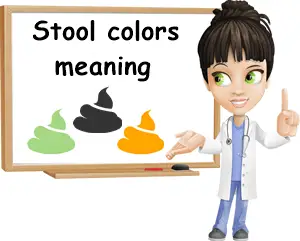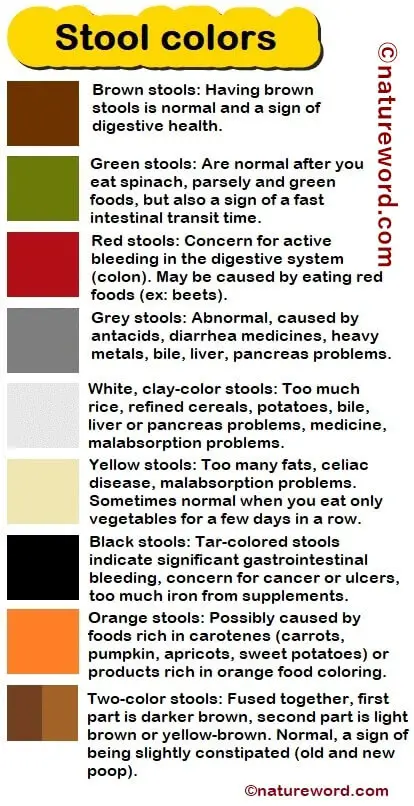Bowel movements speak bundles about our health. From stool frequency to shape, consistency, texture, odor, weight and color, every little detail says something about how healthy we are and how well we eat. Stool color in particular is extremely relevant to our health as differences in pigmentation may indicate either a change in dietary habits or an underlying condition or ailment. Color of bowel movements may range from different shades of brown to yellow-brown and very light yellow, almost white, to grey, green, orange, different shades of red and black. Sometimes, stools have two different colors.
What color are normal bowel movements? Normal bowel movement colors are different shades of brown, from brown with a yellow tint to dark brown, but without red undertones. A bowel movement with two colors is also normal, as long as the two colors are two different shades of brown, usually a darker brown followed by a lighter, yellowish brown. Unusual bowel movement colors are green, bright red, dark red-brown (maroon), black, too pale a yellow, light grey or clay-colored.

For the most part, red and black stools and very light-colored stools, almost lacking pigment indicate a hidden pathology. Red and maroon most commonly indicate bleeding, but so does black – the color black is a sign of bleeding higher in the gastrointestinal tract (old blood). Green, yellow and sometimes red and black stools may be normal, a result of eating foods with strong green, yellow, red or dark pigments. Below is a more in detail explanation of stool colors and what they say about your health.
What do stool colors mean?
1) Brown stools. The normal stool color is brown and represents an indicator of digestive health. Color may vary from a lighter brown with yellow undertones to a darker brown. It’s important there are no red undertones to brown stools because red can be a sign of bleeding. Even a very dark brown stool can be normal, as long as it has no red undertones and it’s not black. A darker color than normal can be a result of eating dark, pigmented foods such as dark chocolate, Oreo biscuits or taking iron supplements, medication containing charcoal or other strongly pigmented foods, supplements and medicines.
It’s also important to keep in mind that a very dark brown stool color is normal if it’s temporary, meaning you’ve eaten lots of dark chocolate and have had a very dark brown stool the following day, but the next bowel movement after that is a more normal brown. The brown color of stools is caused by stercobilin resulting from bilirubin which is produced when the hemoglobin in aging red blood cells is recycled.
2) Green stools. Green stools can be either a lighter, olive-green with yellow tones or a slightly darker, spinach-green. This particular bowel movement color can be both normal, a result of dietary changes and unusual, indicating a pathology. Green stools are normal only after you’ve eaten strongly pigmented green foods like spinach, parsley, kale, collard greens, patience dock, peas, grape leaves, rocket and others. Green smoothies or green juices as well as foods with lots of green food coloring can also cause temporary green stools.
Green stools are unusual if they occur although you haven’t eaten much green foods or at all. In such situations, they happen as a result of an unusual fast transit time which doesn’t allow the gastrointestinal system time to properly digest food. From my experience, eating lots of vegetables, green or other colors, can also cause a too fast a transit and green stools that are usually softer in texture. Just like in the case of green vomit, green stools are caused by bile that hasn’t been properly transformed during digestion (also read Vomit Colors: What They Mean).

3) Red stools. Pink and bright red stools as well as brown stools with red streaks are unusual and indicate bleeding somewhere along the gastrointestinal tract. Bright red colors and red streaks mean the bleeding is recent and close by, usually in the lower part of the gastrointestinal system such as the colon. Reddish stools can be caused by hemorrhoids, fissures, tears, bleeding polyps, benign tumors or cancer (read more about Foods to Eat and to Avoid for Hemorrhoids).
The only time when red stools are normal is when you’ve eaten foods with strong red or purple-red pigments. For example, if you eat red beets, radicchio, red radishes, rhubarb, lots of tomato sauce or foods with red coloring, then it’s likely your next bowel movement will have a reddish tint to it. Beets in particular are responsible for red stools. Tomatoes with skin, red peppers and even watermelon can cause red streaks in otherwise normal-colored stools.
4) Maroon stools. Maroon bowel movements are a darker, red brown. The color may indicate bleeding in the higher part of the gastrointestinal tract and the resulting color is because of blood having been digested. However, depending on how long transit takes, it is possible for the bleeding to occur somewhere in the lower gastrointestinal tract as well. It’s always recommended to see a doctor if you notice any red undertones in your bowel movements.
5) Black stools. This color is the second biggest reason for concern after red on the stool color chart. What having a black stool means is there may be a bleeding somewhere deeper in the gastrointestinal tract. It can come from the esophagus, the stomach, duodenum, from an ulcer, polyp, benign tumor or a cancer. The dark color is the result of blood being old enough to have been digested. The reason why black stools constitute a medical emergency is because, for the pigment to be this pronounced, there has to be a significant amount of bleeding.
However, if it’s a temporary, infrequent occurrence brought on by dietary changes, black stool color can be considered normal. For example, taking iron supplements, eating plenty of foods rich in iron such as parsley or dark chocolate or dark-colored foods like Oreo, black licorice can cause temporary black stools. Color should start returning to normal after the first black stool and the pigment eliminated completely soon after. However, if you experience black stools often and have not eaten any dark-colored foods, then it’s time to make an appointment with your doctor.
6) Yellow stools. Having yellow stools is relatively normal if you eat lots of dietary fiber and experience a fast transit time as a result of it. I always have yellow stools whenever I eat vegetables for more than two days in a row (only vegetables, more yellow, white and orange ones than green, red or purple). If the stool is well-formed, maintains its shape, is soft, easy to pass and does not smell particularly bad, then it’s normal.
However, it’s not okay to have greasy, foul-smelling yellow stools everyday. Yellow, greasy, smelly, poor formed stools can indicate difficulty digesting food properly, especially fats. There may be a digestive condition causing a form of malabsorption, such as celiac disease, pancreas or liver problems, mild or severe. If you have greasy-looking, bad-smelling, yellow stools, see your doctor. Having yellow bowel movements can also be caused by diarrhea, in which case stools are loose, watery even, or by some anti-diarrhea medication.
7) Orange stools. Although not very common, orange stools occur when you eat too many orange foods or foods containing orange dyes. Carrots, pumpkin, bell peppers and other similar foods eaten in large amounts can cause you to have orangey bowel movements. Sometimes, there are brown stools with an orange tint.
8) Pale yellow, clay-colored, whitish stools. Eating too many refined carbohydrates such as white rice, pasta, bread, biscuits, crackers, bagels and others can cause temporary whitish or light colored stools. Large amounts of potatoes and milk can also cause a temporary stool discoloration. However, discolored stools are unusual and not normal. What causes pale yellow, clay-colored or whitish stools is low bile production, either because of a blockage of the bile ducts, liver infection such as hepatitis, pancreas problems etc. Medication such as antacids or anti-diarrhea medication (example: bismuth subsalicylate) can cause stool discoloration as well. If you experience frequent clay-colored, pale yellow or whitish stools that appear to lack pigment, make an appointment with your doctor as soon as possible.
9) Grey stools. Grey stools are a subtype of discolored stools and can be brought about by liver, gallbladder or pancreas problems causing a lack of bile or caused by certain medication, especially antacids and anti-diarrhea medicines.

10) Two colors-stools. When you have a stool of two different colors, it is often normal. You may usually get a darker brown stool at first, fused with a lighter brown, sometimes yellowish stool. Both parts can be smooth, soft, well-shaped and easy to pass. Or the darker brown stool may have cracks or lumps, while the yellow one may be soft and smooth. You may pass them together at once, or the brown one first, followed by the lighter brown or yellowish stool right after. In my experience, stools of two different colors occur when you experience constipation (didn’t drink enough water, didn’t eat enough food or couldn’t evacuate bowel movements entirely last time). By the time that bout of constipation is relieved, you have two bowel movements from two successive transit sequences at once.
Conclusion
Changes in bowel movements may occur at any time during one’s life and are often harmless, dictated by sudden changes in normal eating habits. For example, you may eat lots of chocolate one day and get a dark-colored stool the next, or simply too much spinach or parsley and have one or two green or dark colored bowel movements. As long as stool color changes are temporary and can be explained by changes in eating habits, they can be considered normal. But if you experience more than one or two unusual stool colors and cannot explain them, especially if you also show symptoms like diarrhea, fever, abdominal pain, weight loss and others, then it’s important you make an appointment with your doctor as soon as possible.
